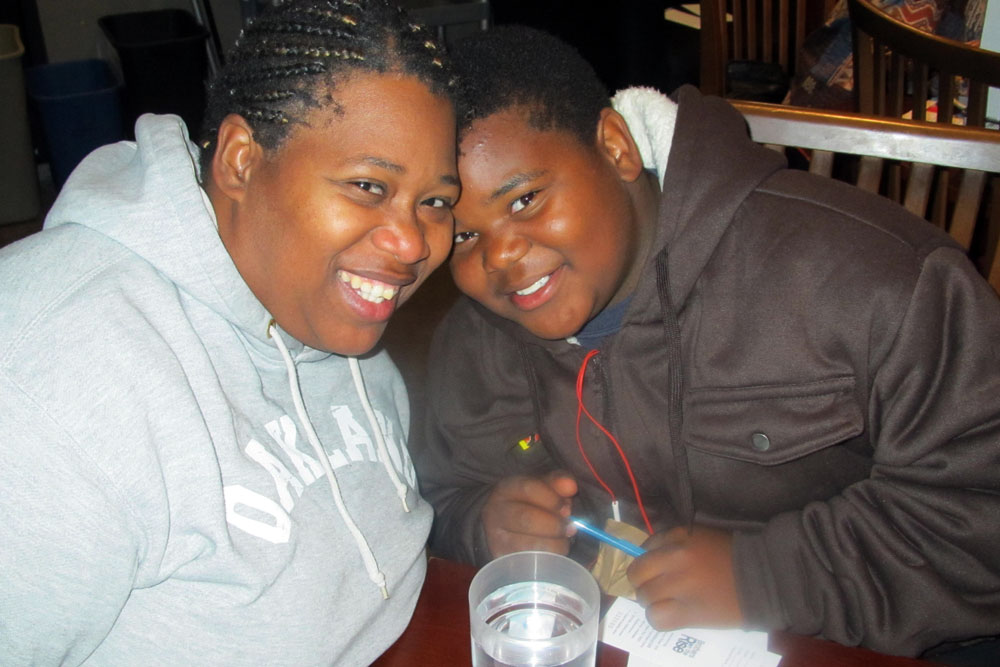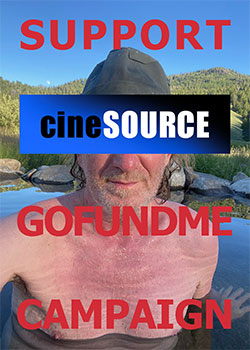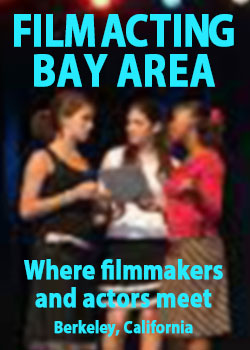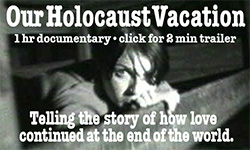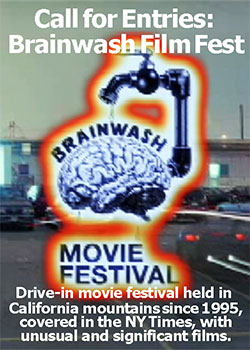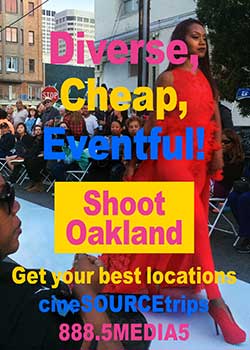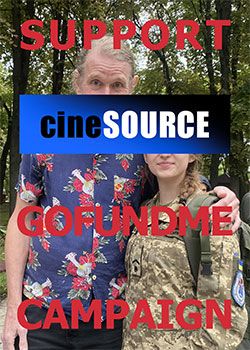Urban Youth Eyes State of the Nation
by Joanne Butcher
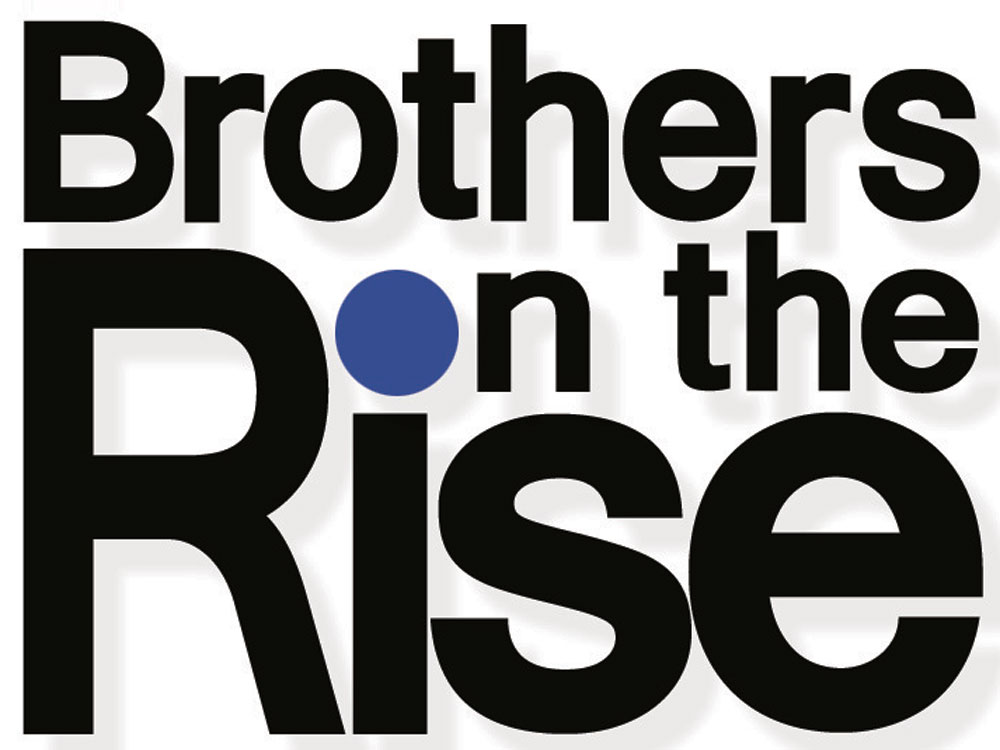 Logo for a festival held at Oakland's Parkway theater spotlighting underserved youth. photo: courtesy J. ButcherFOR MANY YEARS, MONTH AFTER
Logo for a festival held at Oakland's Parkway theater spotlighting underserved youth. photo: courtesy J. ButcherFOR MANY YEARS, MONTH AFTER
month, I ran a program for filmmakers in Florida called—rather unimaginatively, I felt—“Show Us Your Stuff” — for IFP/Miami. Filmmakers gathered and screened up to 10 minutes of work, ranging from short films to parts of works-in-progress, and received feedback from an audience of their peers.
At the same time, I was running the independent theater, Alliance Cinema, Miami Beach (1990—2002). We had a reputation for showing great films, often featuring a New York Times Four-Star review, that a wide variety of people traveled great distances to come to see.
As American independent film came into its own and the multiplexes began showing those same quality films, I was put in charge of closing that theater.
Our cinema also had a reputation for showing gay films. We showed all the films of Derek Jarman, and the early works of Todd Haynes, Gus Van Sant, Greg Araki and so on.
What I witnessed, during that period, was the extraordinary creativity born from a passion to speak and be heard—coupled with a limited access to funds—that comes when a minority begins to find its voice in the medium of film.
On Thursday, December 5th, at the New Parkway Theater, Oakland, the nonprofit, Brothers on the Rise, presented the first annual Bay Area Boys and Young Men of Color Film Festival. Here I witnessed another minority, young men of color, beginning to find its voice in the medium of film with a tone of power, authority, and endless creativity—despite not having two pennies to rub together.
This is not to say that there haven’t been great movies made by young men of color in the past: “Sweet, Sweetback’s Badass Song,” Smoke Signals,” “Boyz in the Hood,” “New Jack City,” “Anuvahood,” “Clockers,” “La Haine,” “City of God,” and more showing what it’s like to be black and living in an urban nightmare of poverty, drugs and violence.
However, like the wave of young gay filmmakers that emerged in the mid-80’s, these young filmmakers of color are both confident in the digital medium and able to deconstruct the distribution and exhibition system that has them trapped in invisibility. They are not merely describing the world they live in, but analyzing, commenting on, and offering alternatives.
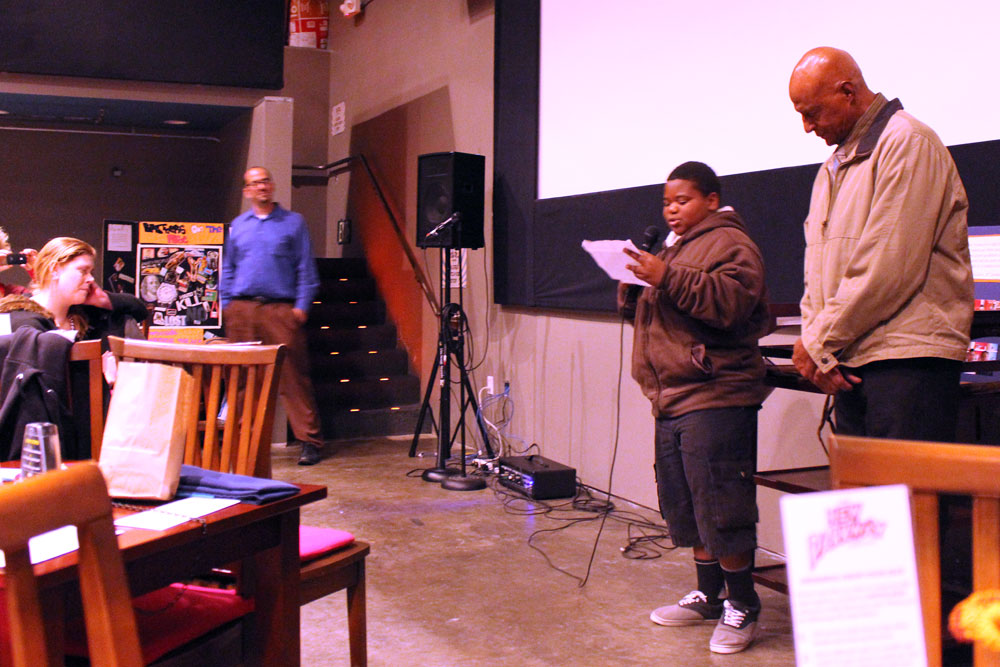 Charlie Henderson, a young West Oakland man, making a presentation at the Film Festival, with his adult mentor. photo: courtesy J. ButcherBay Area-based filmmaker, Ryan Coogler’s “Fruitvale Station” has now set rather high a new bar for conscious filmmaking from the perspective of a young black man in 21st century urban America.
Charlie Henderson, a young West Oakland man, making a presentation at the Film Festival, with his adult mentor. photo: courtesy J. ButcherBay Area-based filmmaker, Ryan Coogler’s “Fruitvale Station” has now set rather high a new bar for conscious filmmaking from the perspective of a young black man in 21st century urban America.
Part of the deconstruction these filmmakers achieve is the realization that unless they find a successful path through the chosen medium of film, their voices will continue to NOT BE HEARD. Because they understand how the system works to silence them, erase them, render them voiceless and invisible, they have to find tools to circumvent those built-in structures.
The foundational element for these young men is violence. According to the video “Rising Above the Violence” by Brothers on the Rise, a group in Oakland dedicated to developing boys into men, virtually all the young men of color in Oakland have witnessed or heard shootings, personally know young men who have been shot, or have been shot at or outright themselves.
Secondly, the issue of voicelessness is central at home, at school and in the community among men who feel they have no other way to establish hierarchy and redress grievances.
But, once young men learn that there are options when dealing with the foundational issue of constant violence, they can start to learn “to open up about the challenges they face,” notes "Rising Above the Violence". Then they can build a supportive community of other men, and speak up politically to make changes in their environment.
The short film “Black Men in the Media” was produced by the DetermiNation Media Group at United Roots, one of the media programs for young people in the Bay Area. The piece discusses the impact of images of young black men in the media, and the significance of positive role models.
Some of the pieces in the show provided the context, the environment and life of the young men, in addition to the concept of initiation and rites of passage for youth of color.
“One of the functions of the initiation is to bring the young person into the community. And all young people have a longing for that,” said “Rites of Passage” director Frederick Marx, who attended to show a selection from his film and discuss filmmaking.
“Rites of Passage” is a feature-length film looking at the costs and devastation of youth violence and based on the premise that when young people do not receive initiation and mentoring into adulthood, chaos ensues.
“If we do not initiate the young, they will burn down the village to feel the heat.” African Proverb. The film looks at how initiation ceremonies, rites of passage, and adult male mentorship turns young men’s lives around.
BAVC’s “History in these Streets” involved a film crew documenting the homes and meeting places of the Black Panther Movement. This piece commented on both the complete erasing of this significant history from the streets and the neighborhoods of Oakland, making the Movement entirely invisible, even to those who live there now.
At the same time the piece makes visible a team/filmcrew of young men doing the documentation. As the young men move from location to location, telling the stories of the historic events that happened, we see the images they show us of vacant lots, empty buildings, not one commemorative mark in place.
Perhaps the most accomplished, technically-speaking, of the films was the sumptuous animation “Two Spirit”, from Injunuity directed and produced by Adrian Baker, and produced by Manny Lieras of the American Indian Child Resource Center.
Bathed in desert color the film told Native American stories with an authentic voice. You can catch a screening somewhere in town or on KQED or on the web.
Director, Peter Nicks also showed a section of his documentary “The Waiting Room” which played theatrically nationwide in early 2013. In it, a young man is rushed into surgery in Highland Hospital, Oakland, after a shooting.
We watch as the narrative-free documentary follows the medical team working on the youth, the mother arriving, and the doctors making a decision as to who is going to pass on the notice of death. Close ups of blood dripped on to the operating room floor and the boy’s shoes help to transform the anonymity of the nightly shootings on the evening news into the personal. Nicks is continuing to work on projects in Oakland and is definitely a director to watch.
Perhaps my favorite piece of the evening, “Street Literature,” by the RYSE Center, includes a number of rap singers rhyming about life on the streets for a black man while the images show each of them in day-to-day situations in Oakland.
The camera watches them with a gaze of fear, racism and discrimination. One singer walks along the Fruitville train station and looks down at where Oscar Grant died. Another buys Skittles and a drink in a store while the camera watches with suspicion. Eventually, each of the young men puts up their black hoodie and turn into Trayvon Martin, one of “the young people of color taken from us too early” to whom the piece is dedicated.
As we watch, we can only hope these young men actually survive the environment they describe in their song. This music video is a beautiful elegy to Trayvon Martin and uses music, voice, poetry, images, themes and concepts in a truly sophisticated and extremely powerful way.
There were three incredibly well told digital stories of local heroes by Killari Meredith, Danny Ruiz and Carlos Canul of the Conscious Media Crew. And a piece about the transformation of Latino men as they set aside their macho cultural beliefs and become available to family and relationship told in “Los Hombres de Casa C.H.E.” from “Historias de la Comunidad,” Group Leader, Juan Cuba.
And “Our Lives Matter” produced by Forward Media and Justin Davis, Kapor Center for Social Impact.
The opening titles state: “ In the wake of the Trayvon Martin tragedy, much has been said about and to young black men. At College Bound Brotherhood, we thought it was time to hear from young Black men themselves.” It’s extremely powerful to hear these young men talk about the way they are perceived by society, all the while trying to succeed in college.
The evening was filled with great film, the generous comments of successful filmmakers, young men and their mentors—some of whom are filmmakers. It will be interesting to watch the future of this work. Go and join one of these organizations and make some movies! Kudos to Brothers on the Rise for bringing together so many filmmakers and media organizations with a focus on Oakland, and look forward to next year’s event.
is a writer, former fundraising consultant to Brothers on the Rise and a big fan of nonprofit film, young filmmakers, and film as art.
Posted on Jan 31, 2014 - 05:24 AM
by Joanne Butcher
 Logo for a festival held at Oakland's Parkway theater spotlighting underserved youth. photo: courtesy J. Butcher
Logo for a festival held at Oakland's Parkway theater spotlighting underserved youth. photo: courtesy J. Butchermonth, I ran a program for filmmakers in Florida called—rather unimaginatively, I felt—“Show Us Your Stuff” — for IFP/Miami. Filmmakers gathered and screened up to 10 minutes of work, ranging from short films to parts of works-in-progress, and received feedback from an audience of their peers.
At the same time, I was running the independent theater, Alliance Cinema, Miami Beach (1990—2002). We had a reputation for showing great films, often featuring a New York Times Four-Star review, that a wide variety of people traveled great distances to come to see.
As American independent film came into its own and the multiplexes began showing those same quality films, I was put in charge of closing that theater.
Our cinema also had a reputation for showing gay films. We showed all the films of Derek Jarman, and the early works of Todd Haynes, Gus Van Sant, Greg Araki and so on.
What I witnessed, during that period, was the extraordinary creativity born from a passion to speak and be heard—coupled with a limited access to funds—that comes when a minority begins to find its voice in the medium of film.
On Thursday, December 5th, at the New Parkway Theater, Oakland, the nonprofit, Brothers on the Rise, presented the first annual Bay Area Boys and Young Men of Color Film Festival. Here I witnessed another minority, young men of color, beginning to find its voice in the medium of film with a tone of power, authority, and endless creativity—despite not having two pennies to rub together.
This is not to say that there haven’t been great movies made by young men of color in the past: “Sweet, Sweetback’s Badass Song,” Smoke Signals,” “Boyz in the Hood,” “New Jack City,” “Anuvahood,” “Clockers,” “La Haine,” “City of God,” and more showing what it’s like to be black and living in an urban nightmare of poverty, drugs and violence.
However, like the wave of young gay filmmakers that emerged in the mid-80’s, these young filmmakers of color are both confident in the digital medium and able to deconstruct the distribution and exhibition system that has them trapped in invisibility. They are not merely describing the world they live in, but analyzing, commenting on, and offering alternatives.
 Charlie Henderson, a young West Oakland man, making a presentation at the Film Festival, with his adult mentor. photo: courtesy J. Butcher
Charlie Henderson, a young West Oakland man, making a presentation at the Film Festival, with his adult mentor. photo: courtesy J. ButcherPart of the deconstruction these filmmakers achieve is the realization that unless they find a successful path through the chosen medium of film, their voices will continue to NOT BE HEARD. Because they understand how the system works to silence them, erase them, render them voiceless and invisible, they have to find tools to circumvent those built-in structures.
The foundational element for these young men is violence. According to the video “Rising Above the Violence” by Brothers on the Rise, a group in Oakland dedicated to developing boys into men, virtually all the young men of color in Oakland have witnessed or heard shootings, personally know young men who have been shot, or have been shot at or outright themselves.
Secondly, the issue of voicelessness is central at home, at school and in the community among men who feel they have no other way to establish hierarchy and redress grievances.
But, once young men learn that there are options when dealing with the foundational issue of constant violence, they can start to learn “to open up about the challenges they face,” notes "Rising Above the Violence". Then they can build a supportive community of other men, and speak up politically to make changes in their environment.
The short film “Black Men in the Media” was produced by the DetermiNation Media Group at United Roots, one of the media programs for young people in the Bay Area. The piece discusses the impact of images of young black men in the media, and the significance of positive role models.
Some of the pieces in the show provided the context, the environment and life of the young men, in addition to the concept of initiation and rites of passage for youth of color.
“One of the functions of the initiation is to bring the young person into the community. And all young people have a longing for that,” said “Rites of Passage” director Frederick Marx, who attended to show a selection from his film and discuss filmmaking.
“Rites of Passage” is a feature-length film looking at the costs and devastation of youth violence and based on the premise that when young people do not receive initiation and mentoring into adulthood, chaos ensues.
“If we do not initiate the young, they will burn down the village to feel the heat.” African Proverb. The film looks at how initiation ceremonies, rites of passage, and adult male mentorship turns young men’s lives around.
BAVC’s “History in these Streets” involved a film crew documenting the homes and meeting places of the Black Panther Movement. This piece commented on both the complete erasing of this significant history from the streets and the neighborhoods of Oakland, making the Movement entirely invisible, even to those who live there now.
At the same time the piece makes visible a team/filmcrew of young men doing the documentation. As the young men move from location to location, telling the stories of the historic events that happened, we see the images they show us of vacant lots, empty buildings, not one commemorative mark in place.
Perhaps the most accomplished, technically-speaking, of the films was the sumptuous animation “Two Spirit”, from Injunuity directed and produced by Adrian Baker, and produced by Manny Lieras of the American Indian Child Resource Center.
Bathed in desert color the film told Native American stories with an authentic voice. You can catch a screening somewhere in town or on KQED or on the web.
Director, Peter Nicks also showed a section of his documentary “The Waiting Room” which played theatrically nationwide in early 2013. In it, a young man is rushed into surgery in Highland Hospital, Oakland, after a shooting.
We watch as the narrative-free documentary follows the medical team working on the youth, the mother arriving, and the doctors making a decision as to who is going to pass on the notice of death. Close ups of blood dripped on to the operating room floor and the boy’s shoes help to transform the anonymity of the nightly shootings on the evening news into the personal. Nicks is continuing to work on projects in Oakland and is definitely a director to watch.
Perhaps my favorite piece of the evening, “Street Literature,” by the RYSE Center, includes a number of rap singers rhyming about life on the streets for a black man while the images show each of them in day-to-day situations in Oakland.
The camera watches them with a gaze of fear, racism and discrimination. One singer walks along the Fruitville train station and looks down at where Oscar Grant died. Another buys Skittles and a drink in a store while the camera watches with suspicion. Eventually, each of the young men puts up their black hoodie and turn into Trayvon Martin, one of “the young people of color taken from us too early” to whom the piece is dedicated.
As we watch, we can only hope these young men actually survive the environment they describe in their song. This music video is a beautiful elegy to Trayvon Martin and uses music, voice, poetry, images, themes and concepts in a truly sophisticated and extremely powerful way.
There were three incredibly well told digital stories of local heroes by Killari Meredith, Danny Ruiz and Carlos Canul of the Conscious Media Crew. And a piece about the transformation of Latino men as they set aside their macho cultural beliefs and become available to family and relationship told in “Los Hombres de Casa C.H.E.” from “Historias de la Comunidad,” Group Leader, Juan Cuba.
And “Our Lives Matter” produced by Forward Media and Justin Davis, Kapor Center for Social Impact.
The opening titles state: “ In the wake of the Trayvon Martin tragedy, much has been said about and to young black men. At College Bound Brotherhood, we thought it was time to hear from young Black men themselves.” It’s extremely powerful to hear these young men talk about the way they are perceived by society, all the while trying to succeed in college.
The evening was filled with great film, the generous comments of successful filmmakers, young men and their mentors—some of whom are filmmakers. It will be interesting to watch the future of this work. Go and join one of these organizations and make some movies! Kudos to Brothers on the Rise for bringing together so many filmmakers and media organizations with a focus on Oakland, and look forward to next year’s event.
is a writer, former fundraising consultant to Brothers on the Rise and a big fan of nonprofit film, young filmmakers, and film as art.
Posted on Jan 31, 2014 - 05:24 AM














